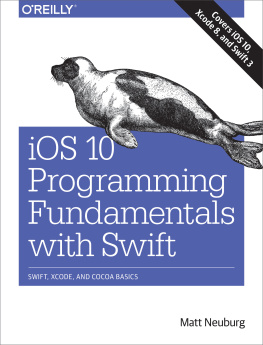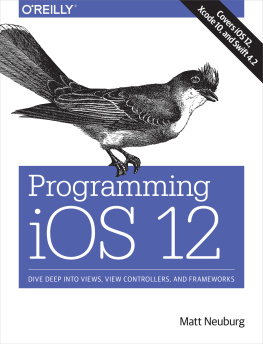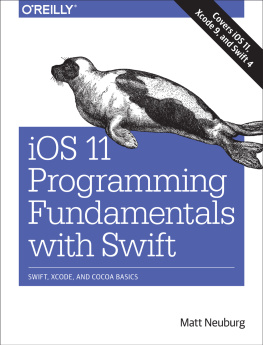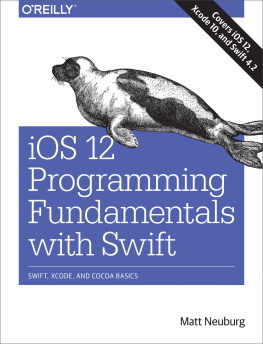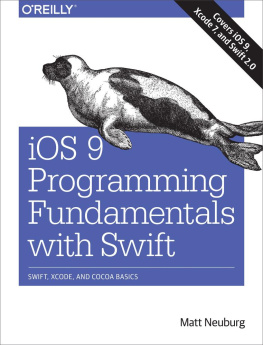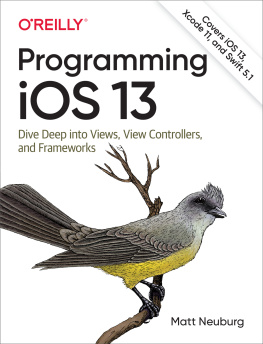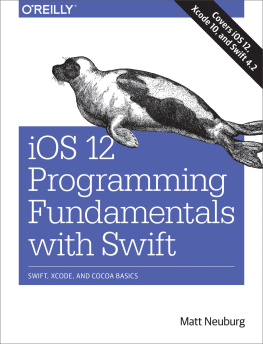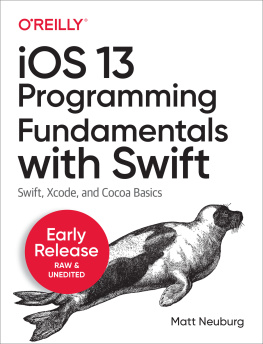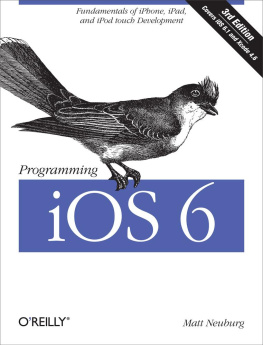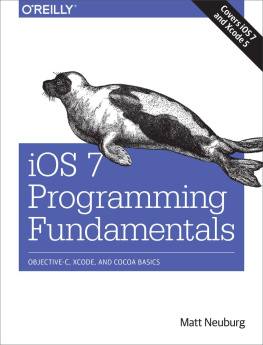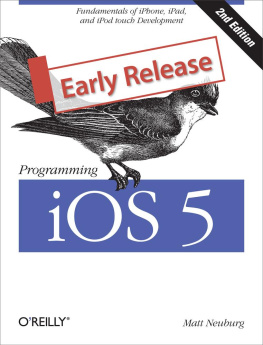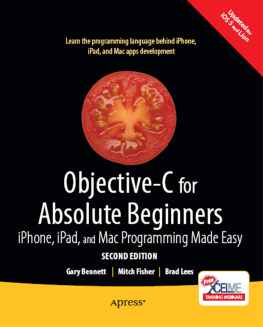Neuburg - Programming iOS 4
Here you can read online Neuburg - Programming iOS 4 full text of the book (entire story) in english for free. Download pdf and epub, get meaning, cover and reviews about this ebook. year: 2011, publisher: OReilly Media, Inc., genre: Computer. Description of the work, (preface) as well as reviews are available. Best literature library LitArk.com created for fans of good reading and offers a wide selection of genres:
Romance novel
Science fiction
Adventure
Detective
Science
History
Home and family
Prose
Art
Politics
Computer
Non-fiction
Religion
Business
Children
Humor
Choose a favorite category and find really read worthwhile books. Enjoy immersion in the world of imagination, feel the emotions of the characters or learn something new for yourself, make an fascinating discovery.

Programming iOS 4: summary, description and annotation
We offer to read an annotation, description, summary or preface (depends on what the author of the book "Programming iOS 4" wrote himself). If you haven't found the necessary information about the book — write in the comments, we will try to find it.
Get a solid grounding in all the fundamentals of Cocoa Touch, and avoid problems during iPhone and iPad app development. With Programming iOS 4, youll dig into Cocoa and learn how to work effectively with Objective-C and Xcode. This book covers iOS 4 in a rigorous, orderly fashionideal whether youre approaching iOS for the first time or need a reference to bolster existing skills.
Programming iOS 4 — read online for free the complete book (whole text) full work
Below is the text of the book, divided by pages. System saving the place of the last page read, allows you to conveniently read the book "Programming iOS 4" online for free, without having to search again every time where you left off. Put a bookmark, and you can go to the page where you finished reading at any time.
Font size:
Interval:
Bookmark:
Copyright 2010 Matt Neuburg
2011-05-26 First release
2011-08-26 Second release
OReilly books may be purchased for educational, business, or sales promotional use. Online editions are also available for most titles (.
Nutshell Handbook, the Nutshell Handbook logo, and the OReilly logo are registered trademarks of OReilly Media, Inc. Programming iOS 4 , the image of a kingbird, and related trade dress are trademarks of OReilly Media, Inc.
Many of the designations used by manufacturers and sellers to distinguish their products are claimed as trademarks. Where those designations appear in this book, and OReilly Media, Inc., was aware of a trademark claim, the designations have been printed in caps or initial caps.
While every precaution has been taken in the preparation of this book, the publisher and authors assume no responsibility for errors or omissions, or for damages resulting from the use of the information contained herein.

Published by OReilly Media
for more information on this offer!
Please note that upgrade offers are not available from sample content.
Supplemental files and examples for this book can be found at http://examples.oreilly.com/0636920010258/. Please use a standard desktop web browser to access these files, as they may not be accessible from all ereader devices.
All code files or examples referenced in the book will be available online. For physical books that ship with an accompanying disc, whenever possible, weve posted all CD/DVD content. Note that while we provide as much of the media content as we are able via free download, we are sometimes limited by licensing restrictions. Please direct any questions or concerns to .
Aut lego vel scribo; doceo scrutorve sophian.
With the advent of version 2 of the iPhone system, Apple proved they could do a remarkable thing adapt their existing Cocoa computer application programming framework to make applications for a touch-based device with limited memory and speed and a dauntingly tiny display. The resulting Cocoa Touch framework, in fact, turned out to be in many ways better than the original Cocoa.
A programming framework has a kind of personality, an overall flavor that provides an insight into the goals and mindset of those who created it. When I first encountered Cocoa Touch, my assessment of its personality was: Wow, the people who wrote this are really clever! On the one hand, the number of built-in interface widgets was severely and deliberately limited; on the other hand, the power and flexibility of some of those widgets, especially such things as UITableView, was greatly enhanced over their Mac OS X counterparts. Even more important, Apple created a particularly brilliant way (UIViewController) to help the programmer make entire blocks of interface come and go and supplant one another in a controlled, hierarchical manner, thus allowing that tiny iPhone display to unfold virtually into multiple interface worlds within a single app without the user becoming lost or confused.
Even more impressive, Apple took the opportunity to recreate and rationalize Cocoa from the ground up as Cocoa Touch. Cocoa itself is very old, having begun life as NeXTStep before Mac OS X even existed. It has grown by accretion and with a certain conservatism in order to maintain something like backward compatibility. With Cocoa Touch, on the other hand, Apple had the opportunity to throw out the baby with the bath water, and they seized this opportunity with both hands.
So, although Cocoa Touch is conceptually based on Mac OS X Cocoa, it is very clearly not Mac OS X Cocoa, nor is it limited or defined by Mac OS X Cocoa. Its an independent creature, a leaner, meaner, smarter Cocoa. I could praise Cocoa Touchs deliberate use of systematization (and its healthy respect for Occams Razor) through numerous examples. Where Mac OS Xs animation layers are glommed onto views as a kind of afterthought, a Cocoa Touch view always has an animation layer counterpart. Memory management policies, such as how top-level objects are managed when a nib loads, are simplified and clarified. And so on.
At the same time, Cocoa Touch is still a form of Cocoa. It still requires a knowledge of Objective-C. It is not a scripting language; it is certainly not aimed at nonprogrammers, like HyperCards HyperTalk or Apples AppleScript. It is still huge and complicated. In fact, its rather difficult.
Meanwhile, Cocoa Touch itself evolves and changes. The iPhone System 2 matured into the iPhone System 3. Then there was a sudden sally in a new direction when the iPad introduced a larger screen and iPhone System 3.2. The iPhone 4 and its double-resolution Retina display also ran on a major system increment, now dubbed iOS 4. Every one of these changes has brought new complexities for the programmer to deal with. To give just one simple example, users rightly complained that switching between apps on the iPhone meant quitting one app and launching another. So Apple gave the iPhone 4 the power of multitasking; the user can switch away from an app and then return to it later to find it still running and in the state it was left previously. All well and good, but now programmers must scurry to make their apps compatible with multitasking, which is not at all trivial.
The popularity of the iPhone, with its largely free or very inexpensive apps, and the subsequent popularity of the iPad, have brought and will continue to bring into the fold many new programmers who see programming for these devices as worthwhile and doable, even though they may not have felt the same way about Mac OS X. Apples own annual WWDC developer conventions have reflected this trend, with their emphasis shifted from Mac OS X to iOS instruction.
The widespread eagerness to program iOS, however, though delightful on the one hand, has also fostered a certain tendency to try to run without first learning to walk. iOS gives the programmer mighty powers that can seem as limitless as imagination itself, but it also has fundamentals. I often see questions online from programmers who are evidently deep into the creation of some interesting app, but who are stymied in a way that reveals quite clearly that they are unfamiliar with the basics of the very world in which they are so happily cavorting.
It is this state of affairs that has motivated me to write this book, which is intended to ground the reader in the fundamentals of iOS. I love Cocoa and have long wished to write about it, but it is iOS and its popularity that has given me a proximate excuse to do so. Indeed, my working title was Fundamentals of Cocoa Touch Programming. Here I have attempted to marshal and expound, in what I hope is a pedagogically helpful and instructive yet ruthlessly Euclidean and logical order, the principles on which sound iOS programming rests, including a good basic knowledge of Objective-C (starting with C itself) and the nature of object-oriented programming, advice on the use of the tools, the full story on how Cocoa objects are instantiated, referred to, put in communication with one another, and managed over their lifetimes, and a survey of the primary interface widgets and other common tasks. My hope, as with my previous books, is that you will both read this book cover to cover (learning something new often enough to keep you turning the pages) and keep it by you as a handy reference.
Font size:
Interval:
Bookmark:
Similar books «Programming iOS 4»
Look at similar books to Programming iOS 4. We have selected literature similar in name and meaning in the hope of providing readers with more options to find new, interesting, not yet read works.
Discussion, reviews of the book Programming iOS 4 and just readers' own opinions. Leave your comments, write what you think about the work, its meaning or the main characters. Specify what exactly you liked and what you didn't like, and why you think so.

